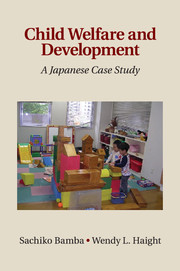Book contents
- Frontmatter
- Contents
- Tables and Figures
- Acknowledgments
- 1 Child-rearing at a Residential Child Care Institution
- 2 Japanese Contexts and Concepts
- 3 The Research Program
- 4 A Developmental Goal for Maltreated Children
- 5 Challenges to Maltreated Children’s Ibasho Creation
- 6 Socialization Practices Underlying Ibasho Creation
- 7 Children’s Lives and Experiences of Ibasho and Mimamori
- 8 Mr. Watanabe’s Responses to the Intervention
- 9 Reflections on Some Challenges of Field Research
- 10 The Emerging Child Welfare Context of Jidou Yougo Shisetsu
- 11 Conclusion: Some Lessons for Culturally Sensitive Child Welfare
- References
- Index
11 - Conclusion: Some Lessons for Culturally Sensitive Child Welfare
Published online by Cambridge University Press: 07 October 2011
- Frontmatter
- Contents
- Tables and Figures
- Acknowledgments
- 1 Child-rearing at a Residential Child Care Institution
- 2 Japanese Contexts and Concepts
- 3 The Research Program
- 4 A Developmental Goal for Maltreated Children
- 5 Challenges to Maltreated Children’s Ibasho Creation
- 6 Socialization Practices Underlying Ibasho Creation
- 7 Children’s Lives and Experiences of Ibasho and Mimamori
- 8 Mr. Watanabe’s Responses to the Intervention
- 9 Reflections on Some Challenges of Field Research
- 10 The Emerging Child Welfare Context of Jidou Yougo Shisetsu
- 11 Conclusion: Some Lessons for Culturally Sensitive Child Welfare
- References
- Index
Summary
Sachiko: You attend (Elementary School) since this school year. How is your current school for you?
Misa: When I was at home, I was beaten all the time, and I couldn’t be relaxed even at school … because everyone asked me, “What happened?” “What happened?” After I came to (Elementary School), I am able to stay calm.
In this interview, a nine-year-old girl discussed how a safe and stable life at the Dream Home helped her to recover psychologically from physical abuse by her stepfather. This child went on to spend nearly forty-five minutes sketching the institution: her house, her room, and peers in her house on a white board with colored pens and colored magnets, and talking about everyday life in her house. She discussed her friends at school including the times she goes to visit them in their homes after school, and they visit her at the institution
- Type
- Chapter
- Information
- Child Welfare and DevelopmentA Japanese Case Study, pp. 189 - 198Publisher: Cambridge University PressPrint publication year: 2011

